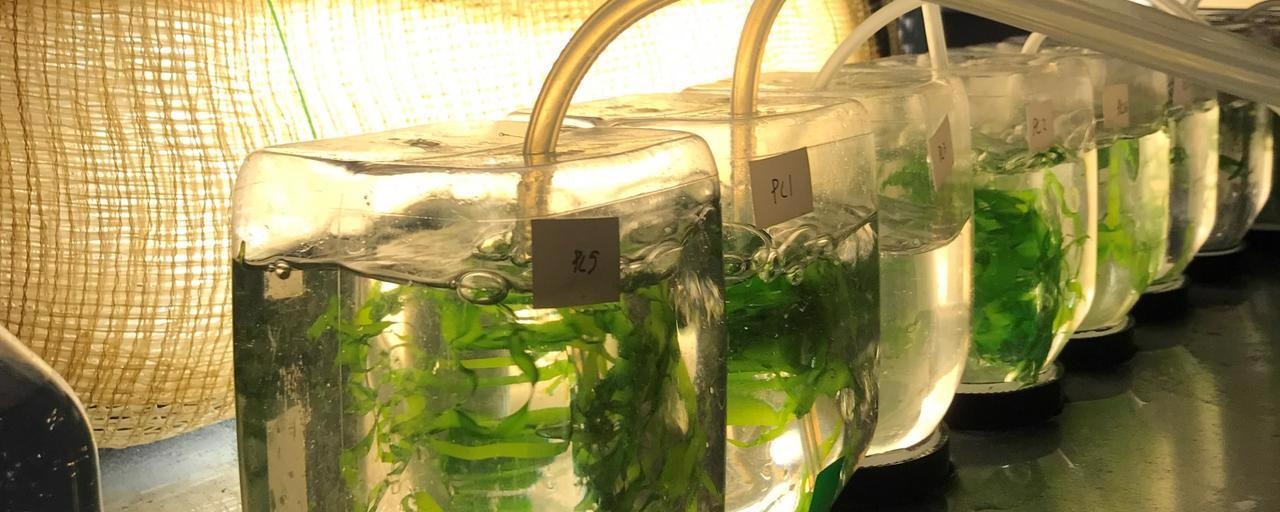For land-based seaweed cultivation, process water from the food sector is an exceptional fertilizer. The seaweed grows faster and its protein content multiplies. In this way, process water can go from being a cost to becoming a resource in the food industry.
 A certain amount of process water with a controlled content of nitrogen was added to the seaweed cultivation. The result showed that the seaweed grew up to 60% faster, and the protein content quadrupled with the addition of process water. Image Credit: Kristoffer Stedt
A certain amount of process water with a controlled content of nitrogen was added to the seaweed cultivation. The result showed that the seaweed grew up to 60% faster, and the protein content quadrupled with the addition of process water. Image Credit: Kristoffer Stedt
Is it possible for macroalgae, like sea lettuce, to turn into a competitive protein source in the foods of the future in the same manner as soybeans are nowadays? Seaweed innately has a lower protein content compared to soybeans, but with fertilizer that difference reduces.
An article from scientists at the University of Gothenburg and Chalmers University of Technology illustrates that process water from food manufacture can act as an exceptional fertilizer in the cultivation of seaweed. The seaweed grew over 60% faster, and the protein content multiplied with the incorporation of process water.
The protein content of soybeans is about 40 per cent. By using process water, we have increased the protein content in the seaweed to more than 30 per cent.
Kristoffer Stedt, Doctoral Student, Department of Marine Sciences, University of Gothenburg
There is an awareness that algae growth is better in the vicinity of fish farms in the sea because of nutrients in fish feces that diffuse in the water. Process water from food industries is most abundant in phosphorus and nitrogen in a similar manner.
Different Food Producers
The scientists experimented with four diverse types of seaweed and incorporated process water from a number of different food manufacturers—from the herring industry, shellfish processors, salmon farming and a producer of oat milk. A specific quantity of process water with a regulated content of nitrogen was used in the seaweed cultivation. After 8 days, the scientists examined the outcomes.
“We included oat milk to achieve cultivation that was completely vegan. And it turned out that all different types of process water worked well as fertilizer for the seaweed,” says Stedt.
Food production necessitates large quantities of water, and regulating the process water is, at present, a cost for manufacturers. But this water can be converted into a beneficial resource.
We think that you could have land-based cultivations of algae, such as sea lettuce, near a herring factory, for example. Seaweed cultivation can cleanse large portions of the nutrients from the process water. That brings us closer to a sustainable approach, and the companies have another leg to stand on.
Kristoffer Stedt, Doctoral Student, Department of Marine Sciences, University of Gothenburg
No Off-Taste for the Seaweed
The scientists were concerned that the seaweed would be contaminated by the process water. Not many will appreciate sea lettuce with herring flavor. However, test panels did not detect any effect on the taste of the seaweed due to the process water.
Going forward, Kristoffer Stedt and his team will concentrate on expanding the experiments concerning seaweed cultivation. They will make use of the process water from the herring industry, which demonstrated very encouraging results, and concentrate on the species Ulva fenestrata (sea lettuce).
We need to conduct tests in larger volumes as a first step in a controlled environment. But we believe that this may be an alternative source of protein in future foods. It could also be a completely circular system if we used cultivated seaweed as feed for salmon culture on land and used the process water to fertilize the seaweed cultivation.
Kristoffer Stedt, Doctoral Student, Department of Marine Sciences, University of Gothenburg
Great Need for New Protein Sources
About 10 billion people are estimated to inhabit the Earth by 2050, and there is a huge demand for sustainably created food protein. From 2000 to 2018, the manufacture of seaweed tripled, reaching 32 million tons. Nearly 99% is manufactured in the Far East.
In the research project titled CirkAlg, scientists from the University of Gothenburg and Chalmers University of Technology are working together on processes that can produce a new Swedish sea protein source in a resource-efficient manner via both processing and cultivation of seaweed.
In addition to boosting the seaweed’s protein content with process water, we are looking at several ways to extract the proteins from the algae for use in other foods in the same way as protein is extracted from soybeans today. However, this presents a challenge, because the protein in seaweed is bound more tightly than in the soybeans.
Ingrid Undeland, Professor of Food Science, Department of Biology and Biological Engineering, Chalmers University of Technology
Ingrid Undeland is also the coordinator for CirkAlg.
Journal Reference:
Stedt, K., et al. (2022) Cultivation of seaweeds in food production process waters: Evaluation of growth and crude protein content. Algal Research. doi.org/10.1016/j.algal.2022.102647.